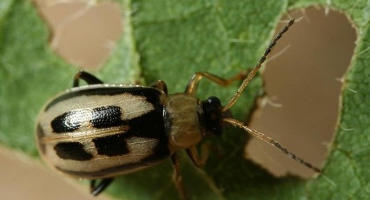By John Tooker
We are getting a wide variety of reports from across Pennsylvania on the severity of feeding in soybeans by bean leaf beetles. In some fields, they are absent or hard to find, while in others they may be causing economic damage (Figure 1). To find out for yourself, get out and walk your fields! Importantly, folks need to recognize that bean leaf beetle can have variable coloration; it can be tan or red with spots or without spots (and a lot of variations in between), but the key is the black triangle at the top of its hard wing covers (Figure 2).

Figure 1: Defoliation from bean leaf beetle in Lancaster County.

Figure 2: Bean leaf beetle feeding on soybeans. The color of, and pattern of spots on, beetles can be variable, but all bean leaf beetles have a black triangle just behind their thorax
As far as damage goes, we are fortunate that soybeans can tolerate a large amount of defoliation without losing yield. In vegetative stages, they can tolerate upwards of 25% defoliation, so often bean leaf beetle populations often do not end up causing economic damage even though their numbers may be high. Once the reproductive stages start, however, this tolerance drops to 15% defoliation. It is important to remember that these defoliation percentages are averages of plants across entire yields, not just individual plants. Bean leaf beetle can also damage soybeans by feeding directly on pods, which can leave pod vulnerable to excess moisture and pathogen infections.
To keep an eye on this pest, inspect fields to estimate the amount of feeding damage across the entire field based on the average amount of feeding per plant. Counting beetles per plant can also be helpful. Economic thresholds for bean leaf beetle in the soybean growth stages relevant for this time of year are as follows:
- Bloom to Pod Fill: 20% of leaf area removed and there are 16 or more beetles per foot of row.
- Seed Maturation: 5 to 10% of the pods are damaged, the leaves are green, and there are 10 or more beetles per foot of row.
Of course, if damage or beetle populations exceed economic thresholds, growers will need to weigh the benefits of control against the cost of running over bean with a sprayer.
Source: psu.edu